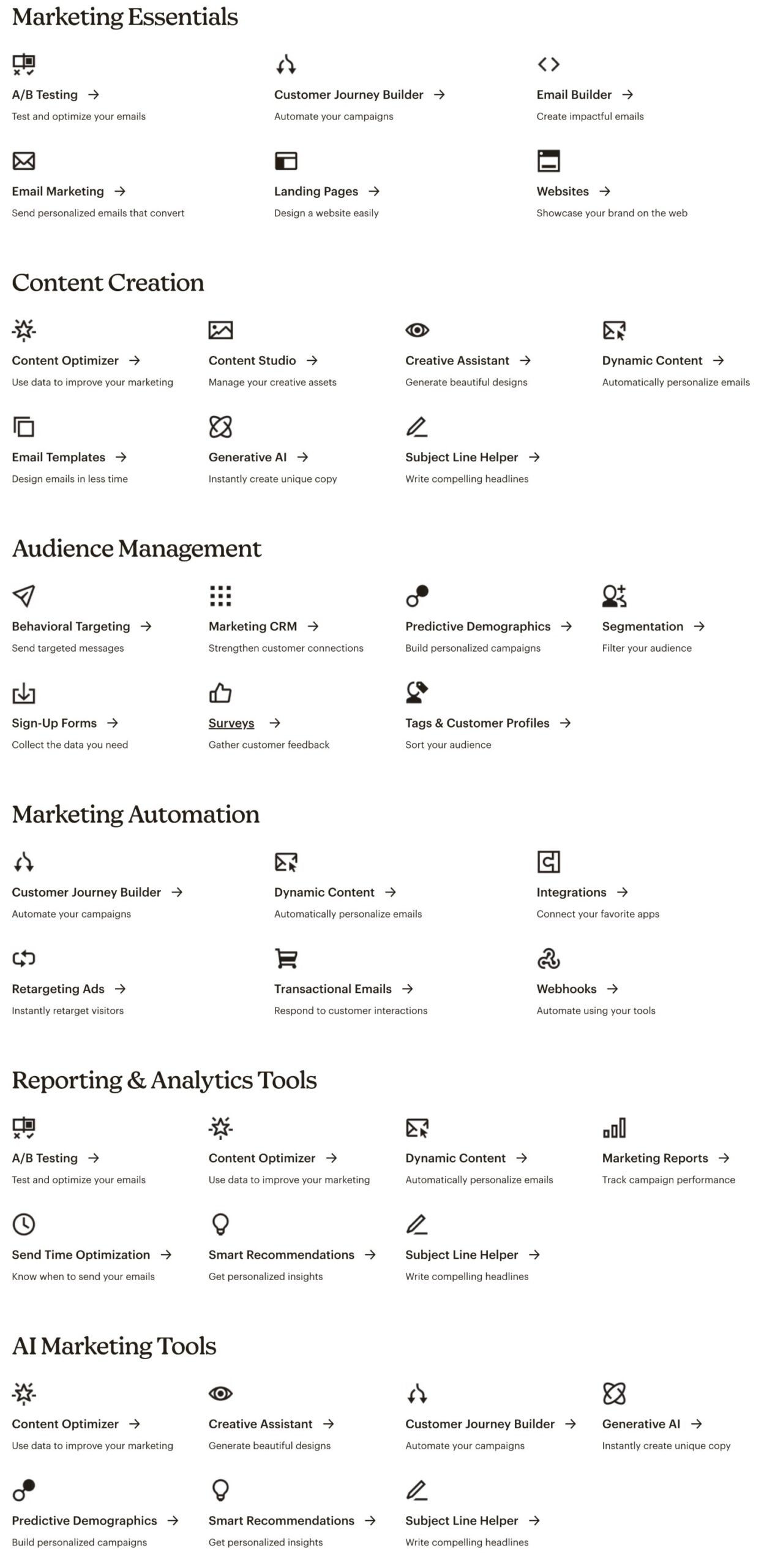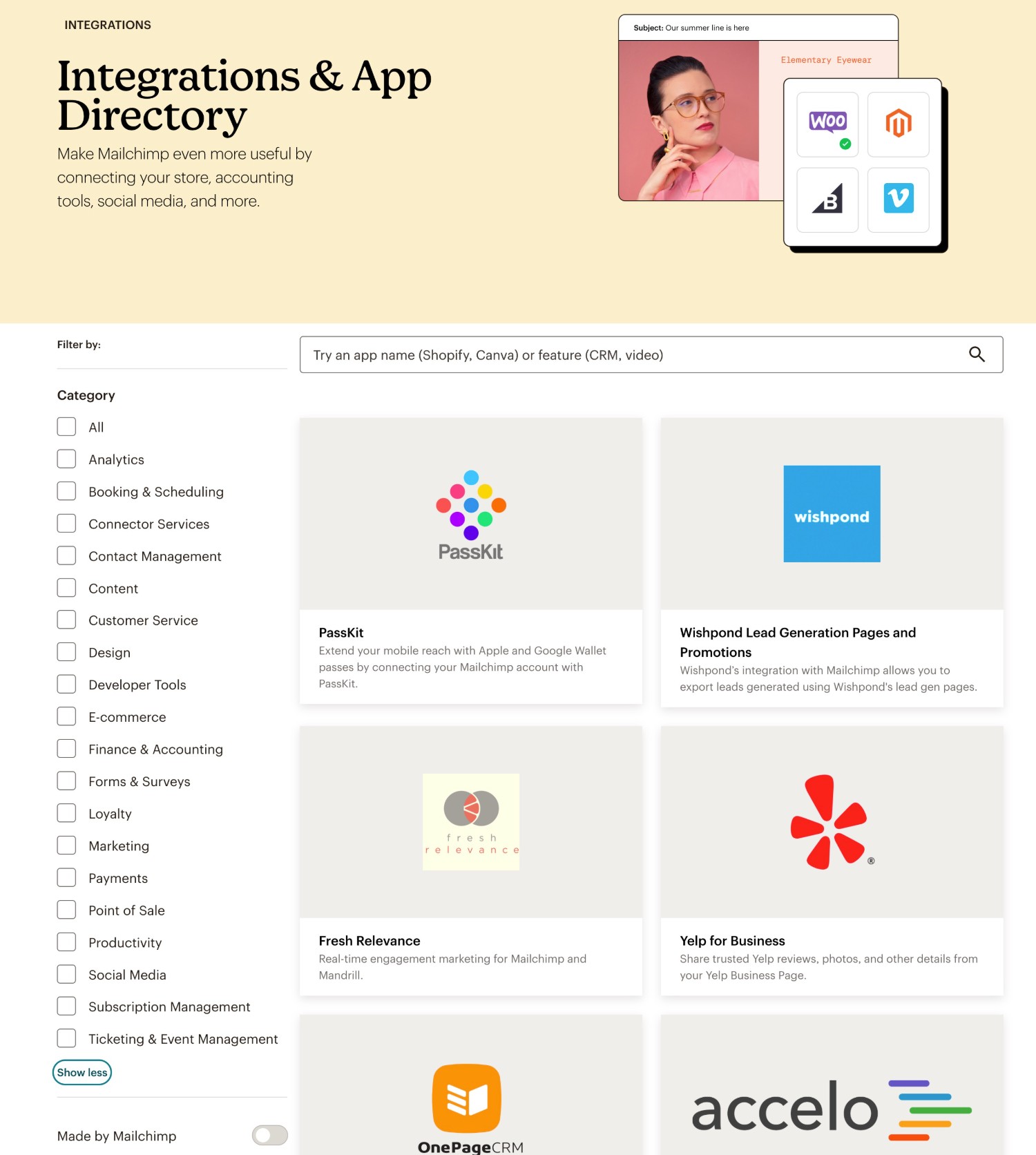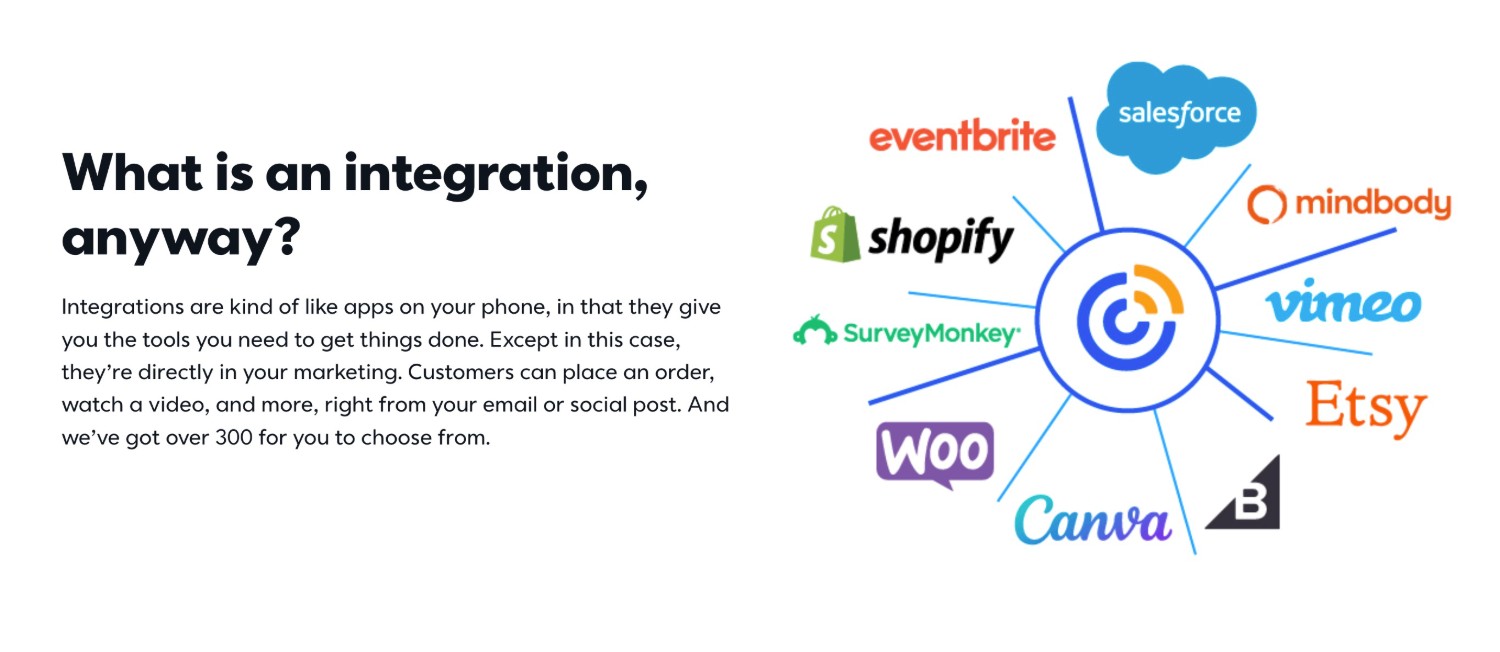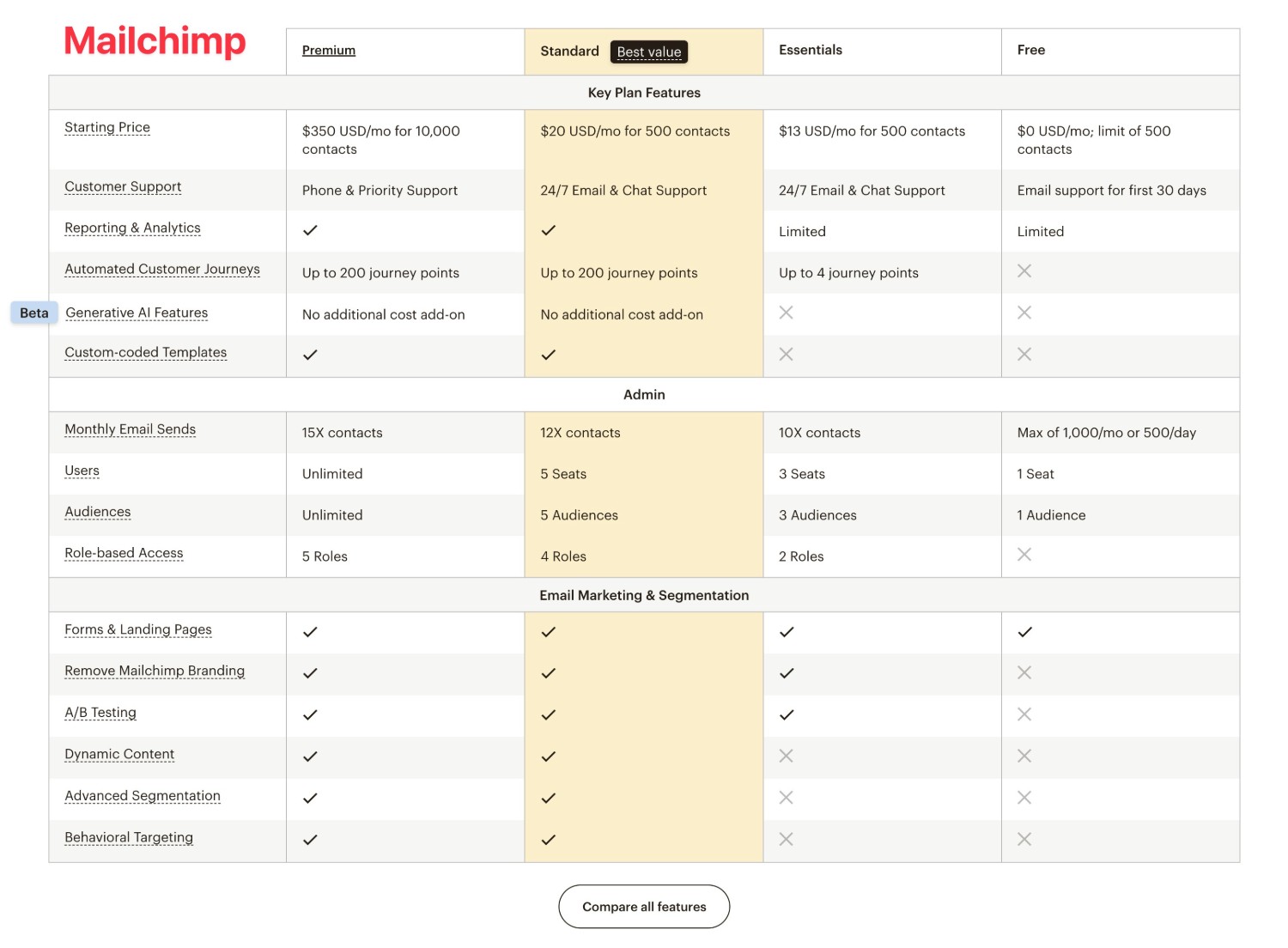Mailchimp vs Constant Contact: A Detailed Comparison
Trying to choose between Mailchimp vs Constant Contact as the email marketing solution for your website?
Both Mailchimp and Constant Contact work well with WordPress and the Gravity Forms plugin, so you won’t make a “wrong” decision between the two.
However, there are some differences that might make one tool better than the other for your specific situation, which is what we’ll try to uncover in this post.
We’re not going to pick a single winner. Instead, we’ll just highlight their similarities and differences to help you make the right choice.
Key Features: Mailchimp vs Constant Contact
To kick things off, let’s take a look at some of the key features that you can access with Mailchimp and Constant Contact.
Both services can handle all the core email marketing functionality that most website owners need, but you might find some smaller differences that push you in one direction or another.
Mailchimp Email Marketing Features
- List management tools and segmentation – You can organize your contacts into different audiences and apply tags as needed.
- Drag-and-drop email builder – While you’re free to use your own HTML templates, Mailchimp also has a visual, drag-and-drop email builder.
- 200+ email templates – To help you save time, Mailchimp offers over 200+ pre-made templates.
- Detailed segmentation – You can create hyper-focused segments using a variety of different conditions. Mailchimp also integrates with most popular ecommerce platforms to allow you to send emails based on shopping behavior.
- Visual automation builder – You can set up simple or complex automations using the visual builder, including leveraging 50+ different triggers in your automations.
- Detailed analytics – You can view click/open rates, demographic details, ecommerce metrics, and more.
- Ecommerce integrations. Mailchimp integrates with WooCommerce, Shopify, and other popular ecommerce platforms.
- A/B testing tools – You can test different subject lines, content, and even send times to find what works best. The send time testing is a unique option that Mailchimp has when compared to Constant Contact.
- AI content creation tools – Mailchimp includes AI tools for text and image generation.

Other Features in Mailchimp
Mailchimp also offers some other features that go beyond email marketing.
For WordPress users, the most interesting service is probably Mailchimp Transactional (formerly Mandrill).
If you pair Mailchimp Transactional with a WordPress SMTP plugin like Gravity SMTP, you can use Mailchimp to send all of your WordPress site’s transactional emails in addition to marketing emails.
We have a guide on setting up WordPress Mailchimp Transactional email sending with Gravity SMTP if you’re interested.
There are ways to send some transactional emails with Constant Contact, but it doesn’t offer a dedicated service like Mailchimp and it’s not ideal for that.
Here are some other features that Mailchimp offers:
- SMS marketing – In addition to emails, you can also send text messages to contacts using SMS. You can currently use it in 12+ different countries including the USA and Canada, as well as a number of European countries and Australia. This is broader support than Constant Contact, which only supports SMS marketing in the USA.
- Lightweight customer relationship manager (CRM) – While Constant Contact’s CRM functionality is a little more robust, Mailchimp does still include a lightweight CRM.
- Social media marketing – You can create and manage posts for various social media networks. Mailchimp can also help you quickly create designs for multiple channels and manage them from one spot.
- Website builder – You can use this to build landing pages or entire websites. If you’re already using WordPress, this might not move the needle. But if you’re looking for one tool to manage your business’s entire online presence, this could be a point in Mailchimp’s favor because Constant Contact stopped offering its website builder in 2023.
Integrations in Mailchimp
In total, Mailchimp integrates with 300+ different services across various categories including ecommerce, analytics, booking/scheduling, subscription management, and more. You can browse all of Mailchimp’s integrations here.

Gravity Forms also offers its own dedicated add-on for Mailchimp, which we’ll discuss later in this post.
Constant Contact Email Marketing Features
- List management tools and segmentation – You can organize contacts into lists, apply tags, and create segments as needed.
- Drag-and-drop email builder – You can design and customize your emails using a visual, drag-and-drop builder.
- 200+ pre-made templates – While you can create your own designs from scratch, you can also choose from hundreds of pre-made templates.
- Automations – You can create targeted automations using a visual builder, including building in time delays and branching paths based on user interactions.
- Email analytics – You can see analytics reports including clicks, opens, and other engagement metrics.
- Ecommerce integrations – Higher-tier plans offer special ecommerce integrations and automations, which are great for WooCommerce or Shopify stores.
- AI content generation – If you want to experiment with AI content generation, Constant Contact offers tools to do it.
- A/B testing – Higher-tier plans let you run A/B tests to compare different subject lines and email content.

Other Features in Constant Contact
In addition to its email marketing features, Constant Contact also offers a few other digital marketing tools that you might find useful:
- Customer relationship manager (CRM) – Rather than just offering a simple list management tool, Constant Contact has a more robust CRM that includes features such as lead scoring.
- SMS marketing – You can connect with contacts on their smartphones by sending SMS. Note – SMS marketing is currently only available in the USA.
- Social media marketing – You can schedule and post contact to social media, with support for Instagram, Facebook, and LinkedIn. It also includes tools for social media advertising.
- Event promotion/management – You can create and manage events, including managing guest lists and tickets. This is a unique feature that Mailchimp does not currently offer, though Mailchimp does integrate with some third-party event management software.
As we mentioned above, Constant Contact used to offer its own website builder like Mailchimp. However, Constant Contact stopped offering this service in 2023, so it’s no longer something you can use.
Integrations in Constant Contact
Constant Contact also integrates with 300+ different apps, though you’ll need to register for a Constant Contact account to view the full list. You can browse the integration landing page here.

Gravity Forms also offers its own dedicated add-on for Constant Contact, which we’ll discuss later in this post.
Pricing
Next, let’s talk about the pricing differences between Mailchimp vs Constant Contact, as this is probably one of the biggest considerations when choosing an email marketing tool.
For this comparison, we’re going to focus on the email marketing pricing for each tool. Mailchimp has separate pricing for its website builder service.
Both use the same basic pricing approach where the price of your plan changes based on the number of contacts/subscribers you have. On top of that, each service has three different premium pricing tiers, with different features available depending on the tier.
Both also apply monthly email sending limits based on the number of contacts on your plan, with higher-tier plans allowing for a higher multiple. For example, a lower-tier plan might let you send 10X the number of contacts per month while the higher-tier plan might let you send 24X.
Free Plan
One key difference between Constant Contact and Mailchimp is that Mailchimp offers a forever-free plan, whereas Constant Contact does not.
Mailchimp’s free plan limits you to basic features, 500 contacts, and 1,000 email sends per month. However, those limits are high enough for small use cases and it can be nice to not have to pay when you’re just getting started.
While Constant Contact doesn’t have a forever-free plan, it does offer a free trial, so you can test out the service before signing up for a paid plan.
Mailchimp also offers a 14-day free trial of its standard plan in addition to its forever-free plan. After the free trial ends, you can choose between continuing to pay for the premium plan or downgrading your account to the free tier.
Premium Pricing
For the premium plans, both services have three different premium plan tiers, each of which gives you access to a different selection of features.
The exact pricing for each tier will depend on the number of contacts that you have – we’ll look at some examples below.
To start, here are screenshots showing the feature differences between the three premium plans at Constant Contact vs Mailchimp. These are correct at the time of writing.
Mailchimp plan features and starting prices:

Constant Contact plan features and starting prices:

To give you more insights into how the pricing changes based on the number of contacts you have, here are the monthly prices for different numbers of contacts on each service’s entry-level plan – the Essentials plan for Mailchimp and the Lite plan for Constant Contact.
| Mailchimp | Constant Contact | |
| Monthly email send multiplier | 10X contacts | 10X contacts |
| 500 contacts | $13 | $12 |
| 1,000 contacts | $26.50 | $30 |
| 1,500 contacts | $26.50 | $50 |
| 2,500 contacts | $45 | $50 |
| 5,000 contacts | $75 | $80 |
| 10,000 contacts | $110 | $120 |
| 20,000 contacts | $230 | $230 |
| 50,000 contacts | $385 | $430 |
As you can see, Mailchimp’s entry-level plan is generally a little bit cheaper than Constant Contact’s entry-level plan, though the exact difference will depend on how many contacts you have.
For another data point, here’s a comparison of the prices for the mid-tier plans – these plans are named Standard at both Mailchimp and Constant Contact:
| Mailchimp | Constant Contact | |
| Monthly email send multiplier | 12X contacts | 12X contacts |
| 500 contacts | $20 | $35 |
| 1,000 contacts | $45 | $55 |
| 1,500 contacts | $45 | $75 |
| 2,500 contacts | $60 | $75 |
| 5,000 contacts | $100 | $110 |
| 10,000 contacts | $135 | $160 |
| 20,000 contacts | $285 | $260 |
| 50,000 contacts | $450 | $460 |
The same trends hold true, with Mailchimp generally being a bit cheaper, though it does flip in certain situations based on the number of contacts.
The email sending limits are exactly the same at both services, so you won’t find any differences there. Both plugins allow you to exceed your plan’s email send limit, but you’ll need to pay extra.
- Mailchimp will charge you for extra “blocks” of contacts and email sends if you exceed your plan’s limits. You can read about those here.
- Constant Contact charges $0.002 per email over your limit. For example, exceeding your plan’s monthly limit by 1,000 emails would cost you $2.
Pay As You Go Plan
Finally, one unique premium option that Mailchimp offers is a Pay As You Go Plan, which could be a viable alternative if you send emails very infrequently. You can purchase one-time credits based on your usage, starting in blocks of 5,000 credits.
Most of the time, you’ll be better off with one of the monthly plans. However, if you just want a way to build an audience and very occasionally send them emails, this could make Mailchimp a good option.
Gravity Forms Add-Ons
If you built your website with WordPress, you can easily integrate both Mailchimp and Constant Contact into your site using the Gravity Forms plugin.
Gravity Forms offers its own official add-ons for both Mailchimp and Constant Contact that let you easily sync subscribers to your lists after they submit a form.
You can use these add-ons to create dedicated email subscribe forms on your site.
Or, you can connect other types of forms to Mailchimp or Constant Contact. For example, if you create a payment form with Gravity Forms, you could give people an option to subscribe to your newsletter when they submit the payment.
Let’s go through the features in both add-ons…
Gravity Forms Mailchimp Add-On
Here are some of the key features of the Gravity Forms Mailchimp Add-On:
- Sync contacts to Mailchimp audiences – Add a person to your Mailchimp audience(s) when they submit a form.
- Apply tags and notes – Add tags and notes to contacts, including using merge fields to dynamically insert a person’s form data in tags or notes.
- Map form fields to Mailchimp – Map the fields from your form to Mailchimp fields and any custom fields you’ve created in Mailchimp.
- Enable Double opt-in – Enable double opt-in so that people are only added to your audience after they click a link in an automated confirmation email.
- Use conditional logic – Use conditional logic to control when to execute Mailchimp feeds, such as only adding a subscriber if they check a form field to join your newsletter.
You can access the Mailchimp Add-On on all Gravity Forms licenses, including the Basic license. You can purchase your license here.
To see how it works, we have a guide on how to create a Mailchimp signup form.
If you use the Gravity SMTP plugin, you can also use Mailchimp Transactional to send all of your site’s transactional emails, including form notification emails and other transactional emails.
Gravity Forms Constant Contact Add-On
Here are some of the key features of the Gravity Forms Constant Contact Add-On:
- Sync contacts to Constant Contact lists – Automatically add a person to your Constant Contact list(s) after they submit a form.
- Map form fields to Constant Contact – Map fields from your form to fields in Constant Contact. This includes support for any custom fields that you’ve added in Constant Contact.
- Use conditional logic – You can choose to only sync subscribers to Constant Contact if certain conditions are met, such as a user checking a box to join your list.
You can access the Constant Contact Add-On on all Gravity Forms licenses, including the Basic license. You can purchase your license here.
We also have a guide on how to connect WordPress to Constant Contact with Gravity Forms.
Final Thoughts
Overall, there’s really no clear winner between Mailchimp and Constant Contact. Both can be great options for WordPress e-mail marketing, and you should choose the service that meets your unique needs.
If you’re still on the fence, both services offer a 14-day free trial to test out all of the premium functionality, so you can try them both before deciding. After that, Mailchimp offers a forever-free plan, while Constant Contact only offers premium plans.
Finally, Gravity Forms offers its own add-ons for both services, so you’ll be able to easily connect Gravity Forms to your email marketing tool regardless of which service you choose.
You can access both add-ons on all Gravity Forms licenses, so you’ll be able to use them as long as you have an active license.
If you don’t have a Gravity Forms license yet, purchase your license today to get started.

If you want to keep up-to-date with what’s happening on the blog sign up for the Gravity Forms newsletter!

